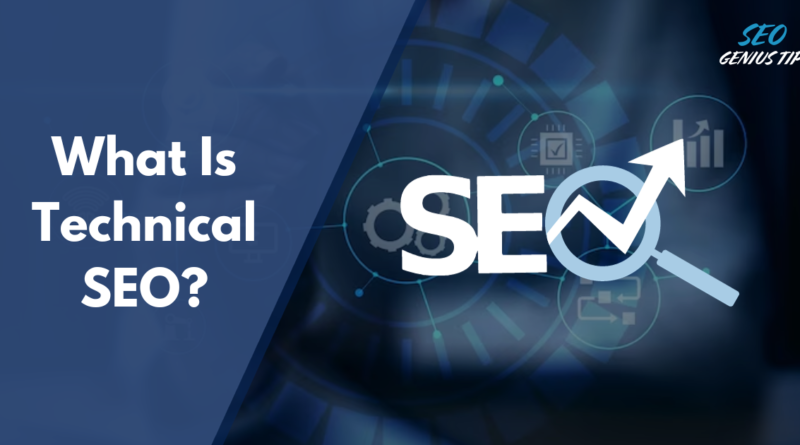What Is Technical SEO? 10 Best Practices For 2024
Learn what technical SEO is and discover easy best practices to make your website search engine-friendly. Master the basics for better online visibility and performance.
Table of Contents
Introduction
In the vast digital landscape, where websites compete for the attention of users and search engines alike, mastering the art of Search Engine Optimization (SEO) is crucial. Among the various facets of SEO, Technical SEO stands out as a powerhouse, capable of propelling websites to new heights in search rankings. In this comprehensive guide, SEO Genius SEO delve deep into the realm of Technical SEO, demystifying its intricacies, exploring its profound impact on online visibility, and providing a roadmap of best practices to navigate this dynamic landscape effectively.

Definition of Technical SEO
At its core, Technical SEO is the backbone of a website’s search engine optimization strategy, focusing on the technical aspects that underpin its online presence. It goes beyond content creation and keywords, delving into the nuts and bolts that ensure search engines can effortlessly crawl, index, and rank a site. From the structure of your website to the intricacies of code and the seamless integration of mobile responsiveness, Technical SEO acts as a silent architect, shaping the digital spaces that users explore.
Components of Technical SEO
A website’s technical health is measured by various components, each playing a pivotal role in determining its performance on search engine results pages (SERPs). Crawlability, indexing efficiency, mobile-friendliness, and page speed all factor into the complex algorithmic equations that determine a website’s fate in the competitive world of online search. Understanding these components and optimizing them strategically can be the key to unlocking unparalleled visibility and, consequently, attracting a broader audience.
Impact of Technical SEO on Rankings and User Experience
The significance of Technical SEO transcends mere technicalities; it directly influences a website’s search rankings and user experience. Search engines reward websites with strong technical foundations, and users gravitate toward sites that load swiftly and offer a seamless browsing experience. In an era where attention spans are fleeting and competition is fierce, Technical SEO emerges as the unsung hero that ensures a website not only ranks high but also keeps visitors engaged.
In the subsequent sections, we’ll unravel the nuances of Technical SEO, elucidating its importance, drawing distinctions from general SEO practices, and presenting a comprehensive set of best practices to empower you on your journey toward online prominence. From website structure to mobile optimization, we’ll guide you through the intricate web of Technical SEO, equipping you with the knowledge needed to not only navigate but thrive in the ever-evolving landscape of digital discovery. So, buckle up as we embark on a journey to demystify Technical SEO and unveil the secrets to a successful online presence.
Why Is Technical SEO Important?
Technical SEO is like the engine that powers your website’s success in search engines. It involves optimizing the technical aspects of your site to make sure search engines can easily understand and rank it. This is crucial because it directly affects how high your website appears in search results.
Technical SEO ensures your website is like a well-organized book. It helps search engines read and index your pages correctly, making it easier for people to find your content. It also focuses on things like page speed and mobile-friendliness, ensuring users have a smooth and enjoyable experience.
In simpler terms, technical SEO is the behind-the-scenes work that makes your website not only visible to search engines but also user-friendly. It’s a set of practices that, when done right, can significantly boost your site’s performance in the digital world. Later on, we’ll explore some specific aspects of technical SEO to understand how they contribute to this overall success.
- Search Engine Crawling: Technical SEO optimizes your website’s structure and coding to facilitate efficient search engine crawling. When search engines can easily navigate and index your content, it enhances your site’s visibility and accessibility in search results.
- Page Speed Impact: Technical SEO plays a vital role in optimizing page speed through various techniques like image compression, browser caching, and minimizing HTTP requests. A faster-loading website not only improves user experience but also satisfies search engine algorithms, positively impacting your search rankings.
- Mobile-Friendly Experience: As mobile usage continues to surge, technical SEO prioritizes mobile optimization, ensuring your site is responsive and delivers a seamless experience across various devices. This mobile-friendliness is a critical factor in search engine ranking algorithms.
- Duplicate Content Prevention: Technical SEO employs canonicalization techniques to prevent issues related to duplicate content. By specifying canonical URLs, you guide search engines on the preferred version of a page, avoiding potential ranking conflicts.
- SSL/HTTPS Boost: Implementing SSL/HTTPS not only secures data transmission but also provides a ranking boost. Search engines favor secure websites, and adopting HTTPS is a fundamental step in technical SEO for trustworthiness and improved rankings.
- Structured Data Enhancement: Technical SEO utilizes structured data markup to provide additional context to search engines. This can result in rich snippets and enhanced search results, increasing the visibility and click-through rates of your pages.
- XML Sitemaps Guidance: Well-optimized XML sitemaps, a product of technical SEO efforts, guide search engines to important pages on your site. This aids in effective indexation, ensuring that your valuable content is properly recognized and included in search engine databases.
- Robots.txt Control: Technical SEO allows you to control search engine crawlers’ access to specific areas of your site through the robots.txt file. This tool enables you to direct crawlers to focus on essential pages, optimizing the indexing process.
- Site Structure Logic: A logical and organized site structure, emphasized by technical SEO, benefits both users and search engines. It enhances user experience by making content easily discoverable, while search engines can efficiently crawl and understand the hierarchy of your website.
- Accessibility and Inclusivity: Technical SEO practices extend to ensuring your website is accessible to all users, including those with disabilities. Implementing accessibility features not only broadens your audience but also aligns with ethical web practices, contributing to a more inclusive online environment.
Difference Between SEO and Technical SEO
Search Engine Optimization (SEO) is a multifaceted discipline aimed at enhancing a website’s visibility in search engine results. Within the broader SEO umbrella, Technical SEO emerges as a specialized subset, concentrating specifically on the technical aspects of website optimization. While both share the common goal of improving a site’s performance in search rankings, they differ significantly in their focus and methodologies. In this exploration, we unravel the key distinctions between SEO and Technical SEO, shedding light on how each contributes uniquely to the digital success of a website.
| Aspect | SEO | Technical SEO |
|---|---|---|
| Scope and Focus | Broad strategies encompassing on-page optimization, content creation, and user experience. | Focus on technical infrastructure, optimizing site speed, mobile responsiveness, crawlability, and indexing. |
| Nature of Optimization | Content, meta tags, headings, keywords, link building, and social signals. | Structure, coding, site speed, SSL/HTTPS implementation, XML sitemaps, and URL optimization. |
| User-Centric vs. Search Engine-Centric | User experience-centric, with an emphasis on creating user-friendly interfaces and engaging content. | Search engine-centric, aligning with algorithms to enhance crawling, indexing, and ranking efficiency. |
| Timeline and Continuity | Ongoing process requiring continuous efforts for content updates, keyword monitoring, and strategy adaptation. | Mix of one-time optimizations (e.g., site speed improvements) and ongoing maintenance (e.g., addressing crawl errors, adapting to algorithm changes). |
| Measurability and Analytics | Metrics include keyword rankings, organic traffic, conversion rates, and user engagement. Measured with tools like Google Analytics. | Metrics involve site speed, mobile-friendliness, crawl errors, and index |
10 Best Technical SEO Practices For 2024
In the vast and dynamic landscape of the internet, achieving online visibility is not just a goal but a strategic imperative. As businesses and individuals vie for attention, Technical SEO emerges as the unsung hero, guiding websites through the complexities of search engine algorithms and user expectations. This comprehensive guide presents an in-depth exploration of the 10 best practices in Technical SEO—a roadmap to not just navigate but conquer the digital terrain.
1. Website Structure and Navigation
A website’s structure is its digital skeleton, and its navigation is the roadmap for both users and search engines. The importance of a logical site structure cannot be overstated. It not only enhances user experience by providing a clear hierarchy and easy navigation but also plays a crucial role in search engine crawls.
Effective website navigation ensures that users can find the information they seek effortlessly. Simultaneously, it allows search engine crawlers to understand the organization of your content, contributing to improved indexation and rankings. A well-designed and logically structured website is the cornerstone of Technical SEO, laying the groundwork for subsequent optimizations.
2. XML Sitemap Optimization
XML sitemaps are the compass that guides search engine crawlers through the intricate maze of your website. These structured files provide a comprehensive list of URLs, signaling to search engines which pages to crawl and index. Optimizing XML sitemaps is a fundamental aspect of Technical SEO, ensuring that your content is discovered and prioritized effectively.
Creating an XML sitemap involves meticulous planning. Each URL should be included strategically, reflecting the importance and hierarchy of pages. Additionally, regular updates to the sitemap accommodate changes to your site’s structure or content, ensuring that search engines have the latest roadmap to navigate your digital landscape.
3. Robots.txt File
In the realm of Technical SEO, the robots.txt file is the gatekeeper, controlling the access of search engine crawlers to different areas of your website. This simple text file, residing at the root of your domain, provides instructions to web robots about which pages should not be crawled.
Understanding the purpose of the robots.txt file is crucial. It allows website owners to exert control over the crawling process, guiding search engine bots and safeguarding sensitive areas. By strategically deploying this file, you can influence how search engines interact with your site, ensuring efficient crawling and optimal indexation.
4. Page Speed Optimization
Page speed is the silent force shaping user experience and search engine rankings. In the age of instant gratification, users expect websites to load swiftly, and search engines prioritize fast-loading pages. Page speed optimization, a key facet of Technical SEO, addresses this need for speed, benefiting both users and search engines.
The impact of page speed on SEO is profound. Slow-loading pages not only frustrate users but also lead to higher bounce rates and diminished conversions. From a search engine perspective, speed is a ranking factor, and faster-loading pages are more likely to secure a coveted spot on the search engine results pages (SERPs).
Optimizing page speed involves a multifaceted approach. Strategies range from optimizing images and leveraging browser caching to minimizing HTTP requests. By implementing these techniques, you enhance the overall performance of your website, creating a seamless and swift experience for users while appeasing the algorithms that determine search rankings.
5. Mobile Optimization
As mobile usage continues to soar, mobile optimization has transitioned from a recommendation to a necessity. Technical SEO recognizes the paramount importance of mobile-friendliness, acknowledging that a website’s adaptability to various devices directly influences both user satisfaction and search engine rankings.
Responsive design stands out as a pivotal aspect of mobile optimization. Ensuring that your website seamlessly adjusts to different screen sizes and resolutions enhances the user experience across a spectrum of devices. Technical SEO best practices for mobile optimization extend to considerations like touch-friendly navigation, legible text, and optimized media for mobile consumption.
Beyond responsive design, mobile optimization encompasses various best practices. Google’s mobile-first indexing emphasizes the need for websites to prioritize their mobile versions, as search engines increasingly rely on the mobile content for ranking and indexing.
In the realm of Technical SEO, mastering mobile optimization is not just about meeting a requirement but about catering to the evolving habits of online users. By prioritizing mobile-friendliness, websites can secure a competitive edge in the digital arena.
6. Canonicalization
Canonicalization is the guardian against the specter of duplicate content—a prevalent issue in the vast realm of the internet. In the intricate landscape of Technical SEO, canonicalization emerges as a crucial practice, preventing confusion for search engines and ensuring that the right version of a page is indexed.
At its core, canonicalization involves specifying the preferred version of a URL when multiple versions of that page exist. This strategic use of canonical tags signals to search engines which version should be prioritized, mitigating the risk of diluting ranking signals due to duplicate content.
Understanding the concept of canonical URLs is fundamental. These canonical tags act as guiding beacons for search engine crawlers, directing them to the primary version of a page. This not only streamlines the indexing process but also consolidates the authority of that particular URL.
Canonicalization plays a pivotal role in maintaining the integrity of a website’s content hierarchy. It ensures that search engines understand the relationships between different versions of a page, preventing dilution of ranking signals and potential confusion in the SERPs.
7. SSL/HTTPS Implementation
In the era of cyber threats and data security, the implementation of SSL/HTTPS has transcended from a security recommendation to a ranking factor. Technical SEO recognizes the importance of securing websites, not only for user trust but also for favorable consideration by search engines.
SSL (Secure Sockets Layer) and its successor, TLS (Transport Layer Security), provide a secure and encrypted connection between a user’s browser and a website’s server. This encryption ensures that sensitive data, such as login credentials or personal information, remains private and secure during transmission.
From a Technical SEO perspective, the implementation of SSL/HTTPS positively influences search engine rankings. Search engines, including Google, prioritize secure websites in their algorithms, considering them more trustworthy and deserving of a higher position in the SERPs.
The impact of SSL/HTTPS on user trust cannot be overstated. When visitors see the padlock icon in the address bar, indicating a secure connection, it instills confidence and reduces the likelihood of bounce rates due to security concerns.
The process of implementing SSL/HTTPS involves obtaining an SSL certificate, configuring server settings, and ensuring that all internal and external resources are served over secure connections. While the technicalities may vary, the overarching goal remains—to create a secure and trustworthy digital environment.
SSL/HTTPS implementation is not just a checkbox in the Technical SEO checklist; it’s a strategic move toward a safer and more resilient web. As cyber threats continue to evolve, prioritizing security is not just a recommendation; it’s an imperative for sustainable online success.
8. Schema Markup
Schema markup is a semantic vocabulary that provides additional context to search engines about the content on your website. It allows you to communicate specific details, such as events, products, reviews, and more, in a structured format. This additional information aids search engines in understanding and presenting your content more effectively.
Schema types, or schemas, cover a wide range of content types. For example, a LocalBusiness schema can provide details about a physical business location, while a Recipe schema can convey the ingredients and steps for a recipe. Implementing schema markup can result in rich snippets, enhancing the visual presentation of your content in search results and increasing click-through rates.
9. Website Crawling and Indexing
Effective website crawling is foundational to search engine indexing. Optimizing crawlability involves strategies such as improving internal linking, using an XML sitemap, and managing URL structures. Ensuring that search engines can discover and access your content is essential for achieving high visibility in search results.
Controlling what gets indexed is crucial for prioritizing essential content and avoiding the indexing of duplicate or low-value pages. Meta robots tags, robots.txt directives, and strategic use of canonicalization contribute to managing indexation. By defining clear directives, you guide search engines on what content should be given prominence in search results.
10. Structured Data Markup
Structured data markup adds a layer of meaning to your content, providing search engines with a deeper understanding of your information. It enhances how your content appears in search results, contributing to richer snippets that attract user attention.
Structured data encompasses a variety of markup types, including Product, Article, Event, and more. Each type offers specific details that search engines can use to create informative snippets. Implementing structured data markup enables search engines to present your content more prominently, making it more appealing to users and potentially increasing click-through rates.
Top 10 Technical SEO Tools
In the intricate landscape of online visibility, Technical SEO tools stand as the digital architect’s blueprint, guiding website owners and marketers in the construction of a robust online presence. These tools serve as digital companions, offering insights, analyses, and actionable recommendations to navigate the complexities of search engine algorithms and enhance a website’s performance. In this comprehensive exploration, we delve into the realm of Technical SEO, unveiling the top 10 tools that empower digital excellence.
From Google Search Console’s authoritative insights to the multifaceted capabilities of SEMrush, Moz Pro, and Ahrefs, each tool plays a pivotal role in optimizing website elements crucial for search engine prominence. Join us on this digital journey as we dissect the functionalities, features, and benefits of these tools, unraveling the intricate layers of Technical SEO and equipping you with the knowledge to propel your online endeavors to new heights.
1. Google Search Console
Google Search Console stands as the foundational cornerstone in the realm of Technical SEO. This official tool provided by Google offers a direct line of communication between website owners and the search giant itself. Unveiling crucial insights into how Google perceives a website, it becomes an indispensable guide in the quest for online prominence. From monitoring search performance and indexing issues to providing detailed data on keywords and user queries, Google Search Console empowers webmasters to fine-tune their strategies for optimal search engine visibility.
2. SEMrush
As a comprehensive SEO toolkit, SEMrush transcends the boundaries of conventional keyword research and backlink analysis. For Technical SEO aficionados, SEMrush emerges as a versatile ally with its site audit capabilities. Unearthing issues related to crawling, indexing, and overall website health, SEMrush provides actionable insights. Armed with a plethora of features, it allows users to dissect the competitive landscape, track keyword trends, and optimize content for superior search engine rankings.
3. Moz Pro
Moz Pro emerges as a powerhouse in the SEO realm, encompassing a spectrum of tools designed to elevate a website’s performance. While renowned for its backlink analysis capabilities, Moz Pro equally excels in Technical SEO. Offering features like site audits, page optimization, and rank tracking, it equips users with a holistic understanding of their website’s strengths and weaknesses. From identifying crawl issues to enhancing on-page elements, Moz Pro stands as a beacon guiding websites towards SEO excellence.
4. Ahrefs
Ahrefs, celebrated for its prowess in backlink analysis, extends its capabilities to the realm of Technical SEO with finesse. As an integral tool for website exploration and competitor analysis, Ahrefs aids in identifying and rectifying issues that influence a website’s performance. From crawlability concerns to indexing challenges, Ahrefs empowers users to traverse the digital landscape with precision, ensuring that their websites stand strong in the face of search engine scrutiny.
5. Screaming Frog SEO Spider
In the labyrinth of website intricacies, the Screaming Frog SEO Spider emerges as a trusty explorer, delving into the deepest recesses of a site’s structure. This desktop application conducts thorough website crawls, providing in-depth data on various SEO elements. Whether it’s uncovering broken links, analyzing page titles, or evaluating meta descriptions, Screaming Frog is a vital tool for on-page optimization and Technical SEO enthusiasts.
6. PageSpeed Insights
Developed by Google, PageSpeed Insights is the speedometer for a website’s performance on the digital highway. Speed is not just a user experience consideration but a pivotal factor in search engine rankings. PageSpeed Insights evaluates a website’s loading speed and provides actionable recommendations for improvement. From optimizing images to leveraging browser caching, this tool is indispensable for ensuring that your website cruises through the digital landscape with optimal speed.
7. GTmetrix:
GTmetrix harmonizes the elements of speed and efficiency, providing a symphony of insights into a website’s performance. This tool delves into page load times, optimization scores, and various components affecting a website’s speed. By compressing images without compromising quality, setting up efficient caching policies, and reducing server requests, GTmetrix contributes to crafting a digital masterpiece that resonates with both users and search engines.
8. WooRank
WooRank emerges as a user-friendly guide in the realm of Technical SEO, providing a comprehensive website audit with actionable insights. Beyond its intuitive interface, WooRank excels in uncovering issues related to crawlability, mobile optimization, and other critical factors influencing search engine rankings. By simplifying complex SEO metrics, WooRank equips website owners with the knowledge to enhance their online presence effectively.
9. DeepCrawl
As the name suggests, DeepCrawl dives deep into the intricate layers of website crawling and analysis. Specialized for comprehensive website exploration, DeepCrawl uncovers technical issues such as duplicate content, broken links, and improper redirects. This tool is instrumental in ensuring optimal crawlability, an essential aspect of Technical SEO that dictates how search engines discover and index a website’s content.
10. Varvy SEO Tool
Varvy SEO Tool stands out by crafting a visual tapestry of SEO insights, offering a clear and concise overview of a website’s performance. This tool covers various Technical SEO aspects, providing insights into mobile-friendliness, page speed, and overall website health. By offering actionable recommendations based on Google’s guidelines, Varvy simplifies the optimization process, ensuring that website owners can navigate the intricacies of SEO with ease.
Summary
In conclusion, the guide emphasizes the continuous and evolving nature of Technical SEO efforts. By implementing the discussed best practices, businesses can fortify their online presence, ensuring sustained visibility and improved user experience. The intricate dance between search engines and websites requires ongoing attention to technical details, making Technical SEO an integral part of any digital marketing strategy.
As digital landscapes evolve, embracing Technical SEO becomes not just a strategy but a necessity. By unraveling its complexities and adhering to best practices, businesses can navigate the digital realm with confidence, ultimately securing a competitive edge in the ever-expanding online marketplace.




